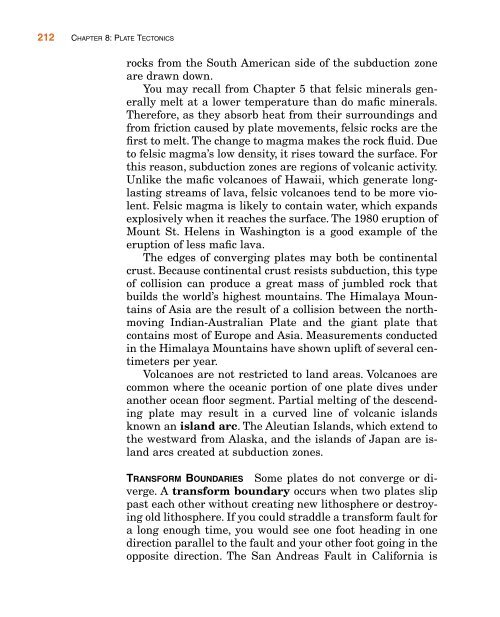Chapter 8 Plate Tectonics
Chapter 8 Plate Tectonics
Chapter 8 Plate Tectonics
You also want an ePaper? Increase the reach of your titles
YUMPU automatically turns print PDFs into web optimized ePapers that Google loves.
212 CHAPTER 8: PLATE TECTONICS<br />
rocks from the South American side of the subduction zone<br />
are drawn down.<br />
You may recall from <strong>Chapter</strong> 5 that felsic minerals generally<br />
melt at a lower temperature than do mafic minerals.<br />
Therefore, as they absorb heat from their surroundings and<br />
from friction caused by plate movements, felsic rocks are the<br />
first to melt. The change to magma makes the rock fluid. Due<br />
to felsic magma’s low density, it rises toward the surface. For<br />
this reason, subduction zones are regions of volcanic activity.<br />
Unlike the mafic volcanoes of Hawaii, which generate longlasting<br />
streams of lava, felsic volcanoes tend to be more violent.<br />
Felsic magma is likely to contain water, which expands<br />
explosively when it reaches the surface. The 1980 eruption of<br />
Mount St. Helens in Washington is a good example of the<br />
eruption of less mafic lava.<br />
The edges of converging plates may both be continental<br />
crust. Because continental crust resists subduction, this type<br />
of collision can produce a great mass of jumbled rock that<br />
builds the world’s highest mountains. The Himalaya Mountains<br />
of Asia are the result of a collision between the northmoving<br />
Indian-Australian <strong>Plate</strong> and the giant plate that<br />
contains most of Europe and Asia. Measurements conducted<br />
in the Himalaya Mountains have shown uplift of several centimeters<br />
per year.<br />
Volcanoes are not restricted to land areas. Volcanoes are<br />
common where the oceanic portion of one plate dives under<br />
another ocean floor segment. Partial melting of the descending<br />
plate may result in a curved line of volcanic islands<br />
known an island arc. The Aleutian Islands, which extend to<br />
the westward from Alaska, and the islands of Japan are island<br />
arcs created at subduction zones.<br />
TRANSFORM BOUNDARIES Some plates do not converge or diverge.<br />
A transform boundary occurs when two plates slip<br />
past each other without creating new lithosphere or destroying<br />
old lithosphere. If you could straddle a transform fault for<br />
a long enough time, you would see one foot heading in one<br />
direction parallel to the fault and your other foot going in the<br />
opposite direction. The San Andreas Fault in California is
















